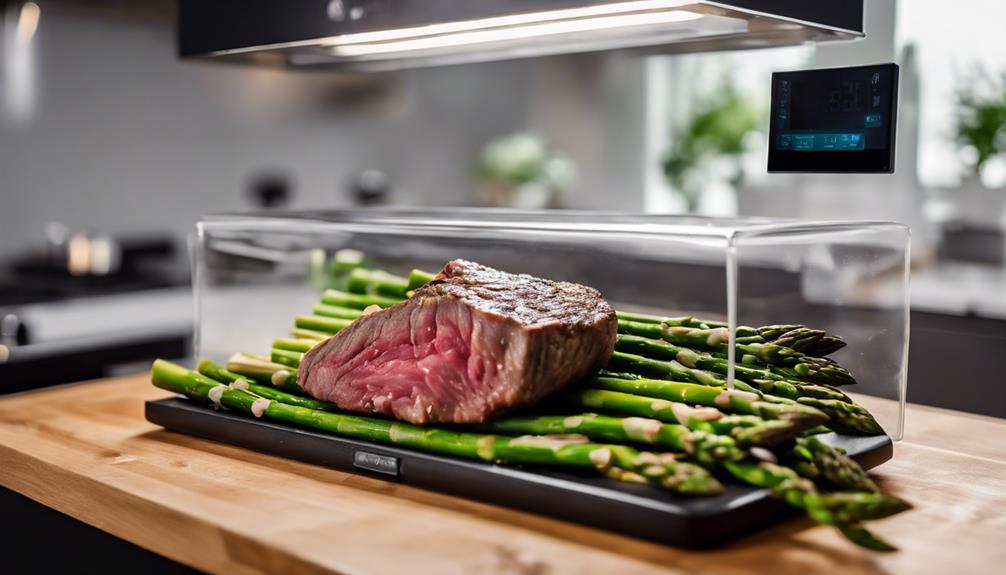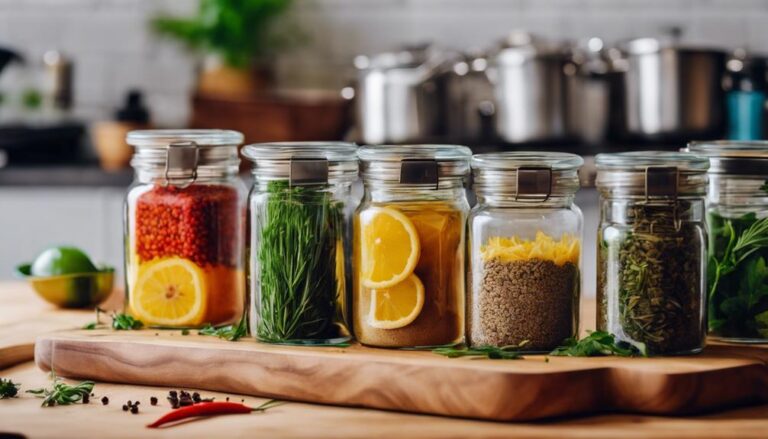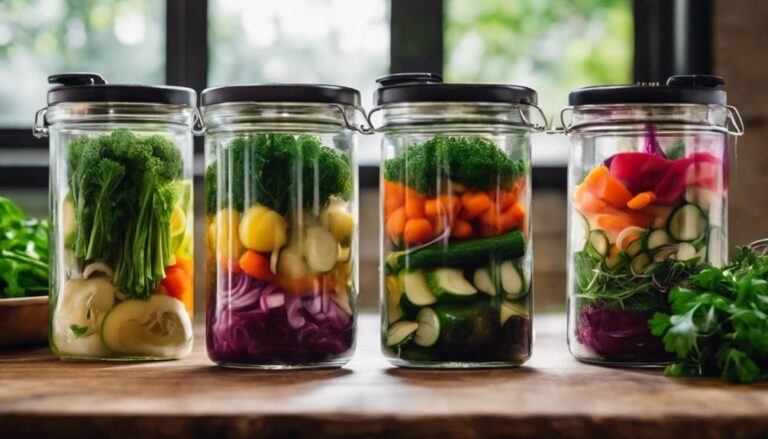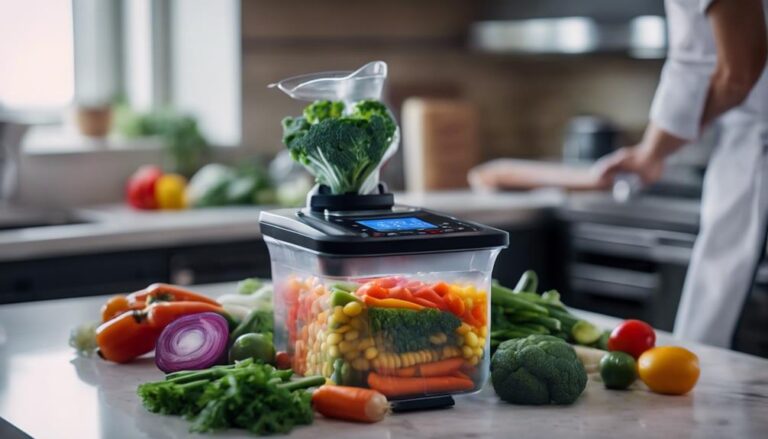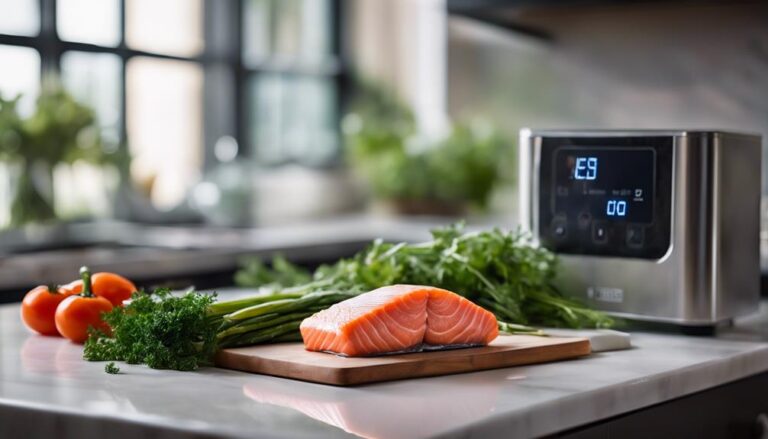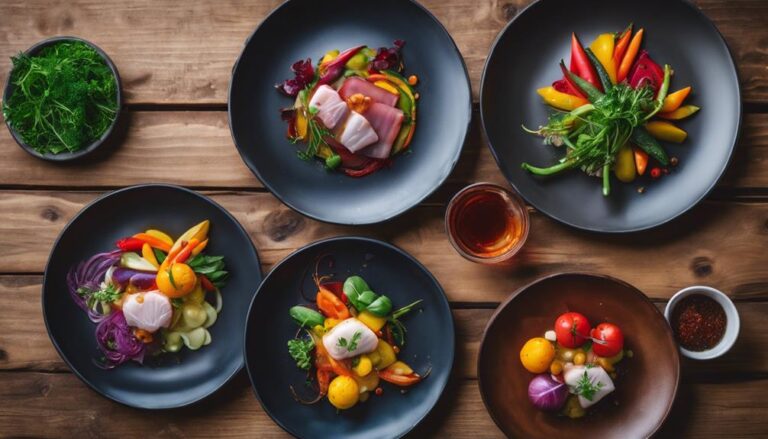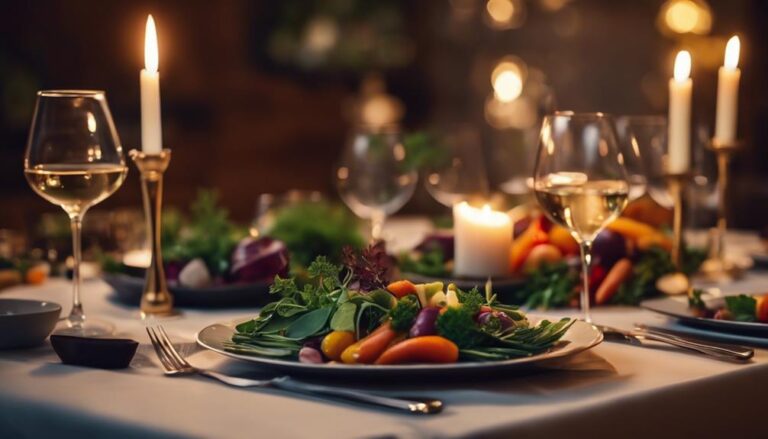Why Sous Vide Cooking Is Ideal for a Low-Carb Diet
Sous vide cooking is ideal for a low-carb diet because it maintains the flavors and textures of lean proteins while preserving essential nutrients. This method uses precise temperature control, ensuring meats stay tender and moist without added carbs. You can explore a range of healthy fats and seasonings, enhancing meal variety without compromising your dietary goals. Additionally, it promotes efficient meal prep, allowing you to batch-cook proteins that can be stored for easy reheating. By transforming inexpensive cuts into flavorful dishes, sous vide cooking can streamline your low-carb lifestyle while maximizing nutrition and taste. There's much more to uncover about this technique.
What You Will Learn Here
- Sous vide cooking retains moisture and flavor in low-carb proteins, enhancing the dining experience without added carbs.
- The method preserves vitamins and minerals, maximizing nutritional benefits while adhering to a low-carb diet.
- Precise temperature control prevents overcooking, ensuring tender and flavorful meals from inexpensive cuts of meat.
- Vacuum-sealing reduces food waste and allows for batch cooking, streamlining meal prep for low-carb diets.
Understanding Sous Vide Cooking
Sous vide cooking is a precise method where you vacuum-seal food and immerse it in a temperature-controlled water bath for perfect results. This innovative technique allows you to cook proteins like meat and fish to the exact level of doneness you prefer, eliminating the risk of overcooking. For those following a low-carb diet, this is especially beneficial, as it guarantees high-quality protein sources remain juicy and flavorful.
With sous vide, the cooking temperatures can be lower than traditional methods, creating a safer environment for meats like chicken and pork while preserving their natural flavors. The gentle cooking process retains moisture, enhancing both texture and taste, which makes your meals more enjoyable.
Additionally, sous vide encourages experimentation with various seasonings and marinades, allowing you to tailor your dishes to suit your culinary preferences. By leveraging this technique, you can elevate your cooking game while adhering to low-carb dietary restrictions.
Fundamentally, understanding sous vide cooking opens up a world of possibilities for creating delicious, perfectly cooked meals that align with your health goals. Embrace this method, and you'll discover a new dimension of culinary innovation.
Essential Equipment for Sous Vide
To achieve the best results with sous vide cooking, you'll need some key equipment that makes the process efficient and effective.
A sous vide machine, like the Anova precision cooker, is vital for maintaining precise temperature control. This guarantees your low-carb proteins, such as meats and fish, are cooked perfectly every time.
A quality vacuum sealer is critical for sealing your food, preventing water from entering the bags and maintaining moisture during cooking. You can also use reusable silicone bags, like Stasher, as an eco-friendly alternative.
For peak cooking, a polycarbonate container with a lid is recommended. It's more space-efficient and energy-efficient compared to traditional pots or pans. While sous vide cooking generally guarantees even doneness, using a thermometer to monitor the internal temperature of food can provide additional reassurance.
If you're looking to enhance your cooking experience, consider optional accessories like a sous vide rack. This will help keep your bags submerged and organized in the water bath, boosting both efficiency and consistency.
With the right equipment, you'll be well on your way to mastering sous vide cooking for your low-carb diet.
Choosing Low-Carb Proteins
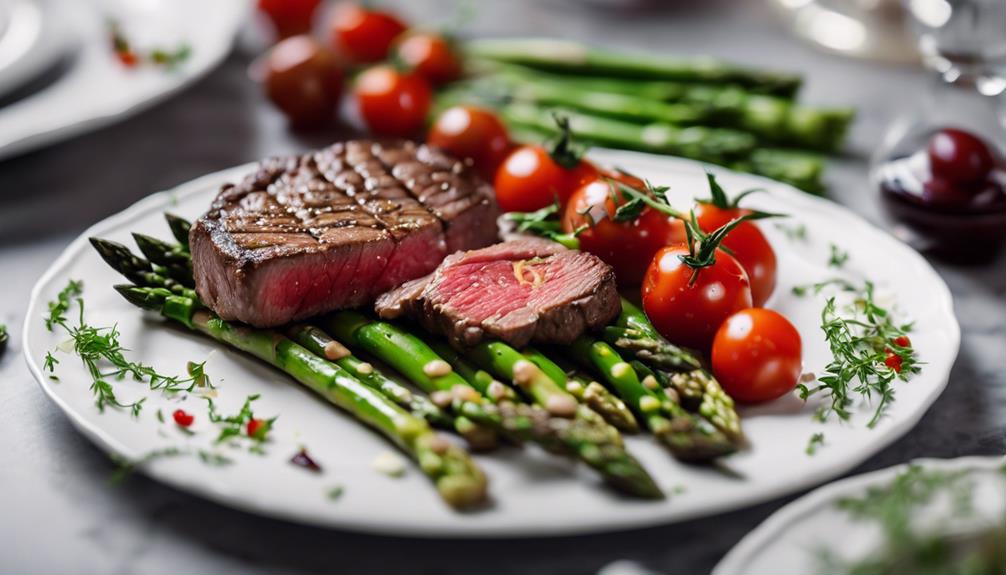
When selecting proteins for your low-carb diet, focus on options that are rich in nutrients and can be perfectly cooked using the sous vide method. This innovative cooking technique allows for precise temperature control, ensuring your meats stay tender and flavorful.
Here are three excellent low-carb protein choices to evaluate:
- Beef: Cuts like sirloin or chuck roast become incredibly tender when cooked sous vide. The low and slow method enhances their flavor while keeping them juicy.
- Pork: Pork butt is another fantastic choice. Sous vide cooking breaks down tough fibers, resulting in melt-in-your-mouth tenderness that's perfect for a satisfying low-carb meal.
- Fish: Options like salmon and cod thrive in sous vide cooking. This method enhances their texture and moisture, making them delicious and filling protein sources.
In addition to these proteins, you can elevate their flavors by adding herbs, spices, and healthy fats during the cooking process. This approach not only aligns with your low-carb goals but also creates richer, more enjoyable meals, making it easier to stick to your diet.
Vacuum Sealing Techniques
When it comes to sous vide cooking, using effective vacuum sealing techniques is essential for achieving the best results.
You'll want to avoid common sealing mistakes that can compromise your food and cooking experience.
Effective Sealing Methods
Effective sealing methods are fundamental for achieving ideal results in sous vide cooking, as they prevent water from entering the bags and assure even cooking.
When you vacuum seal your food, it creates an airtight environment that enhances flavor infusion and guarantees the food cooks uniformly at lower temperatures.
Here are three effective sealing techniques to keep in mind:
- Use a Vacuum Sealer: This is the most reliable method. A vacuum sealer removes air and creates a tight seal, making sure your food stays submerged and cooks perfectly.
- Water Displacement Method: If you don't have a vacuum sealer, use zip-lock bags. Submerge the bag in water to push out air before sealing it. This minimizes air exposure and helps maintain the integrity of your food.
- Clean Sealing Surface: Always keep your sealing area dry and free from grease. A clean surface is vital for a successful seal, as moisture can compromise the vacuum.
Proper sealing usually takes under three minutes, making it a quick step in your sous vide preparation process.
Embrace these techniques to enhance your low-carb cooking experience.
Common Sealing Mistakes
Even with the best sealing methods in place, common mistakes can lead to ineffective seals and compromised sous vide results.
First, always verify the sealing surface of your bags is clean and free from grease or moisture. Contaminants can easily compromise the seal, allowing water to seep in during your sous vide cooking. If you're using zip-lock bags, remember to employ the water displacement method. Submerge the bag in water to force air out before sealing it tightly.
For vacuum sealers, positioning is vital. Make sure the bag's opening is correctly aligned in the machine to avoid incomplete seals that can lead to leaks. Also, leave enough space at the top of the bag—around 2-3 inches—so the vacuum sealer can create an effective seal without any obstruction.
Regular maintenance of your vacuum sealer is important; keep the sealing strip clean to guarantee consistent performance. Neglecting these details could impact your sous vide temperature, resulting in less-than-ideal outcomes.
Cooking Process Overview
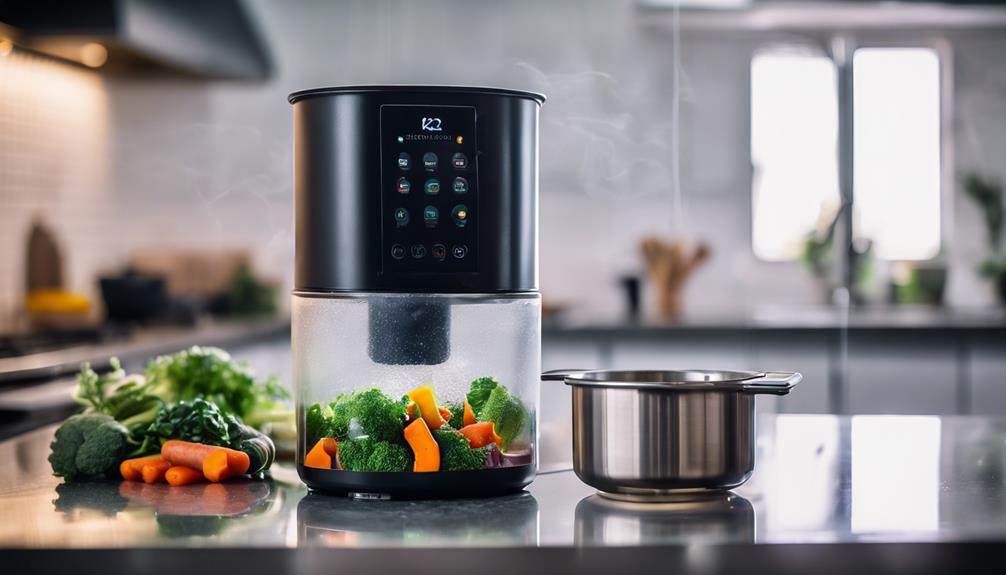
Sous vide cooking seals your food in vacuum bags and immerses it in a precisely controlled water bath, allowing for perfect results every time. This innovative cooking method is particularly advantageous for low-carb diets, especially when you're preparing meat and other protein-rich foods.
Here's a quick overview of the cooking process:
- Preparation: Start by seasoning your meat or vegetables and placing them in vacuum-sealed bags. Confirm they're properly sealed to maintain flavor and moisture.
- Temperature Control: Set your water bath to the desired temperature. Sous vide allows you to cook at lower temperatures for longer periods, which prevents overcooking and drying out your food.
- Cooking Time: Immerse the bags in the water bath for the specified time, depending on the thickness and type of food. This method guarantees even cooking, resulting in tender, flavorful meals.
Flavor Enhancement Through Sous Vide
One of the main benefits of sous vide cooking is its ability to elevate the natural flavors of your ingredients, guaranteeing a more robust taste in every bite. This innovative method utilizes precise temperature control, which enhances flavor enhancement, particularly in meats.
When you cook steak or chicken sous vide, the low-and-slow technique helps make meat incredibly tender, allowing it to retain its juices and flavors without drying out.
Moreover, the sealed environment of sous vide cooking allows seasonings and marinades to infuse deeply into your food. This means you can enhance flavor profiles without relying on additional fats or sugars, making it a perfect fit for a low-carb diet.
Let's not forget about vegetables; sous vide intensifies their flavors too, as the moisture loss is minimized, leading to a delicious side option that complements your meals.
The method's ability to prevent overcooking guarantees that the unique flavors of each ingredient are preserved, providing a more enjoyable meal experience.
Meal Prep Efficiency
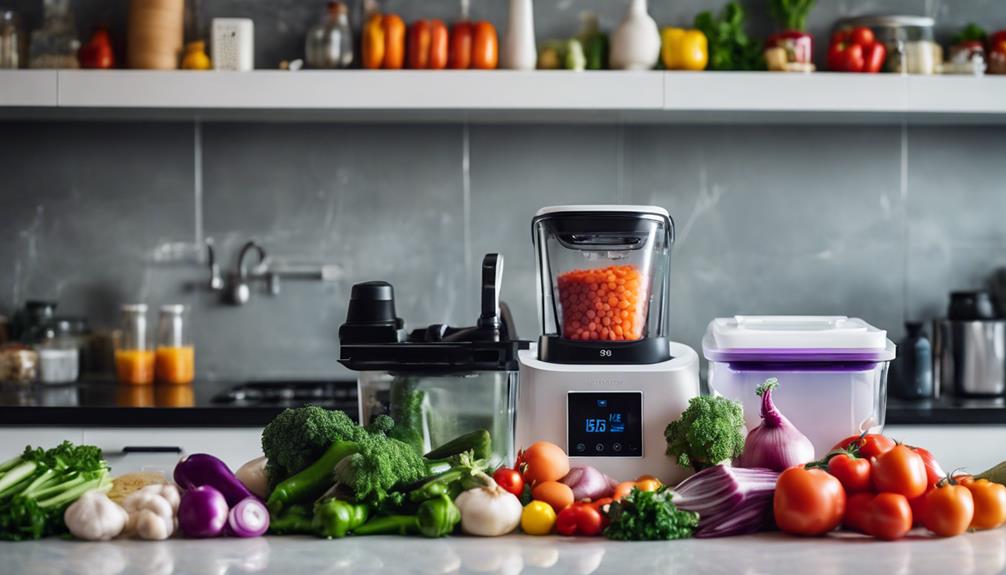
Cooking with sous vide streamlines your meal prep by allowing you to prepare multiple servings of protein-rich foods at once, saving you valuable time throughout the week. This innovative cooking technique enhances meal prep efficiency, making it easier to stick to your low-carb diet.
Here are three ways sous vide helps make meat prep more efficient:
- Batch Cooking: You can cook several portions of different proteins simultaneously in the same water bath. This means you can enjoy a variety of meals without spending hours in the kitchen every day.
- Precise Cooking: Sous vide eliminates the risk of overcooking meats, ensuring that each piece is consistently tender and flavorful. This precision means you won't waste time adjusting your cooking methods or dealing with dry, unappetizing meals.
- Storage and Reheating: Once cooked, vacuum-sealed meals can be stored in the fridge or freezer for quick reheating. This allows you to enjoy delicious, nutritious meals without the hassle of daily cooking.
Nutritional Benefits of Sous Vide
When you cook sous vide, you benefit from nutrient preservation, healthy fats, and enhanced flavors.
By using lower temperatures over longer periods, this method helps keep vitamins and minerals intact, which is essential for a healthy diet.
Plus, the ability to infuse flavors without adding carbs makes your meals more enjoyable while sticking to low-carb guidelines.
Vitamin Preservation Benefits
Sous vide offers remarkable vitamin preservation benefits, allowing you to enjoy meals packed with essential nutrients while minimizing loss typically seen in traditional cooking methods. This innovative technique helps make meat and vegetables retain their vitamins, ensuring you get the most out of your food.
Here are three key benefits of vitamin preservation through sous vide cooking:
- Retention of Nutrients: Studies show that sous vide cooking can retain up to 90% of vitamins like vitamin C, which often disappears during boiling or steaming.
- Minimized Oxidation: The vacuum-sealing process used in sous vide prevents oxidation, protecting sensitive vitamins from degradation that usually occurs in conventional cooking.
- Precise Temperature Control: With sous vide, you can control the cooking temperature accurately, ensuring that foods are cooked just enough to maintain their nutritional integrity without overcooking.
Healthy Fats Focus
Often, you'll find that sous vide cooking enhances the nutritional benefits of healthy fats, making it an ideal method for those following a low-carb diet. This innovative technique allows you to prepare high-fat, low-carb proteins, like fatty cuts of meat and fish, which are rich in healthy fats crucial for a ketogenic lifestyle. Sous vide helps make meat tender and enjoyable while preserving the essential nutrients and moisture.
By cooking at low temperatures, you retain fundamental vitamins and minerals in these fatty foods, promoting better health outcomes. Additionally, the precise temperature control guarantees that you cook meats to an ideal level that maximizes their natural healthy fats without adding extra oils or fats that could increase carb intake. This focus on healthy fats means you can enjoy nutrient-dense, high-fat options that align perfectly with your low-carb dietary goals.
With sous vide, you can take tougher cuts of meat and transform them into mouthwatering dishes, all while emphasizing a healthy fats focus. This method not only simplifies meal preparation but also enhances the overall nutritional profile of your meals, making it a game changer for low-carb enthusiasts.
Enhanced Flavor Profiles
Cooking with sous vide not only emphasizes healthy fats but also elevates the flavor profiles of your meals, guaranteeing every bite is packed with taste without the need for extra calories.
This innovative cooking method helps make meat juicier and more tender while retaining its natural flavors.
Here are three ways sous vide enhances flavor profiles:
- Deep Infusion: Seasoning meats before vacuum sealing allows flavors to penetrate deeply, resulting in a more flavorful dish.
- Moisture Retention: The precise temperature control guarantees proteins keep their moisture, enhancing tenderness and flavor, particularly beneficial for low-carb options like fish and meats.
- Vegetable Intensity: Cooking vegetables sous vide intensifies their natural flavors, making them delicious accompaniments to your meals without heavy sauces or dressings.
Cost-Effectiveness of Sous Vide
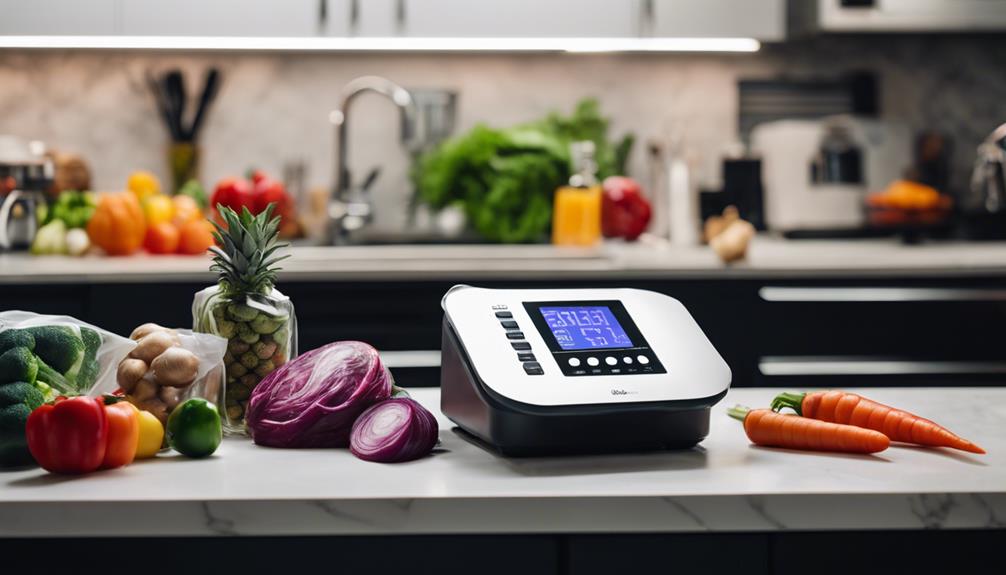
Utilizing sous vide can turn cheaper cuts of meat into tender, flavorful meals, making it a smart choice for anyone on a low-carb diet. The cost-effectiveness of sous vide cooking helps make meat affordable while enhancing its taste and texture. By precisely controlling the cooking temperature, you minimize the risk of overcooking, which reduces food waste and maximizes your investment in ingredients.
Additionally, sous vide methods allow you to create rich flavors without relying on expensive marinades or sauces, helping you keep ingredient costs low. Cooking in bulk is another advantage; you can prepare larger quantities of meat at once, portioning them for multiple meals throughout the week. This not only saves time but also cuts down on meal prep expenses.
Moreover, sous vide cooking is energy-efficient compared to traditional methods that require higher temperatures and longer cooking times. This efficiency can lead to lower utility bills over time, further enhancing the cost-effectiveness of this innovative cooking technique.
Ultimately, sous vide isn't just about gourmet meals; it's a practical, budget-friendly approach to a low-carb lifestyle.
Environmental Considerations
Since sous vide cooking employs precise temperature control, it not only enhances the quality of your meals but also greatly reduces energy consumption and greenhouse gas emissions. By utilizing this innovative technique, you can enjoy environmental benefits while savoring delicious, low-carb meals.
Here are three key environmental considerations to keep in mind:
- Reduced Energy Use: Sous vide cooking often requires less energy than traditional cooking methods, which can help lower your carbon footprint.
- Minimized Water Waste: The water bath method uses considerably less water than boiling or steaming, making it a more sustainable option.
- Less Packaging Waste: Vacuum-sealing ingredients for sous vide can lead to reduced packaging waste compared to pre-packaged meals, promoting a cleaner environment.
Additionally, sous vide helps make meat more tender and flavorful, allowing you to explore cheaper cuts. This not only reduces food waste but also encourages sustainable eating practices.
Frequently Asked Questions
What Is the Advantage of Sous Vide Cooking?
Sous vide cooking gives you precise control over temperature, ensuring perfect doneness every time. It locks in moisture and flavors, making your meals more enjoyable while preserving nutrients, which keeps your culinary experiences innovative and exciting.
Is Cooking Sous Vide Healthier?
Absolutely, cooking sous vide is healthier! You preserve nutrients, enhance natural flavors without extra fats, and reduce harmful compounds. Plus, it tenderizes meat perfectly, ensuring you enjoy delicious, nutritious meals every time.
Is Sous Vide Chicken Healthy?
Yes, sous vide chicken's healthy! It cooks at precise temperatures, ensuring moisture and flavor while preserving nutrients. You minimize foodborne risks and control fat intake, making it an innovative choice for nutritious meals.
What's the Big Deal About Sous Vide?
Sous vide's a game-changer! You enjoy consistent, perfectly cooked meals every time. Its precise temperature control enhances flavors, retains nutrients, and lets you explore creative recipes, making your cooking experience both innovative and exciting.
Conclusion
To summarize, sous vide cooking is an excellent choice for anyone following a low-carb diet.
It allows you to prepare flavorful, perfectly cooked meals while retaining essential nutrients.
With the right equipment and techniques, you can efficiently meal prep and enjoy a variety of low-carb proteins.
Plus, sous vide offers cost-effective and environmentally friendly options.
By integrating this method into your cooking routine, you can enhance your dietary choices without sacrificing taste or quality.
